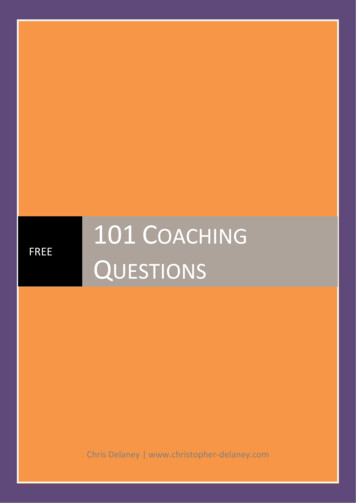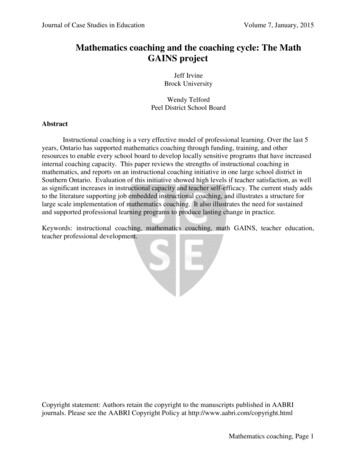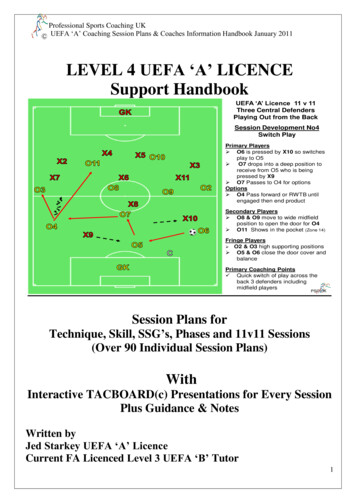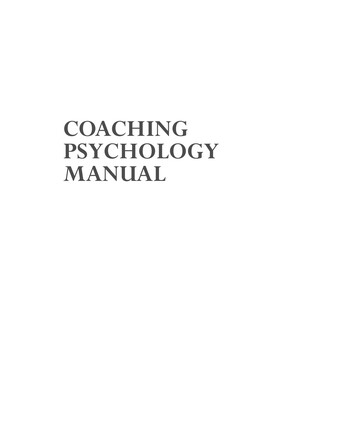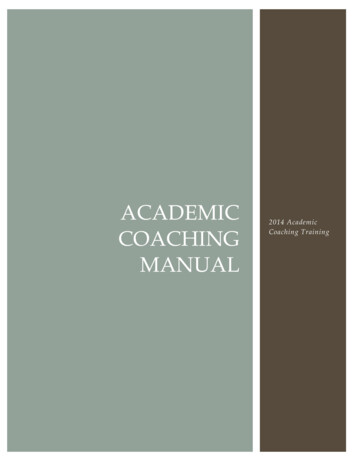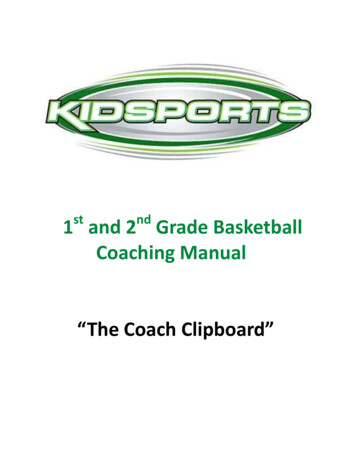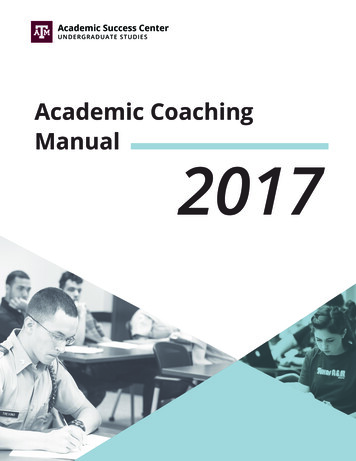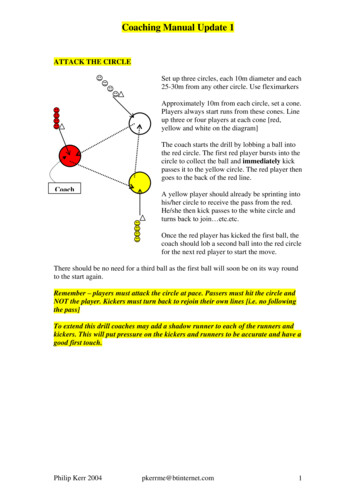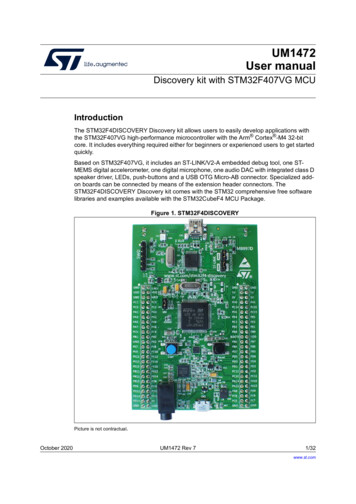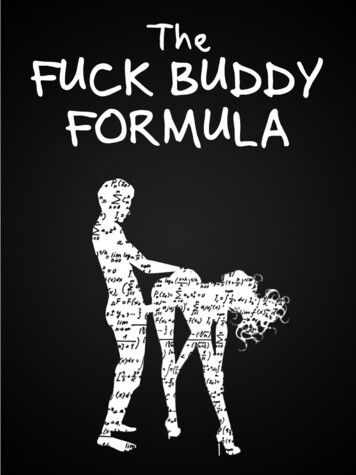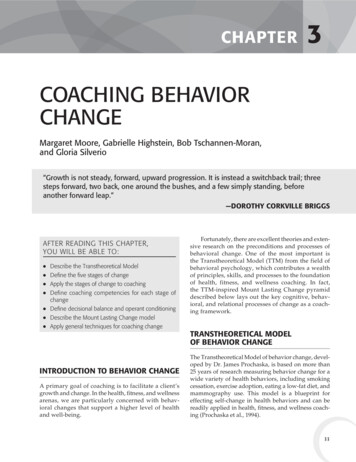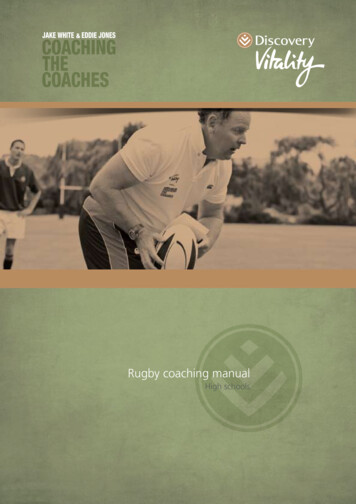
Transcription
Rugby coaching manualHigh schools
Contents Aims of manual. 1 Message from Professor Tim Noakes: The value of sports science in rugby coaching. 2 Rugby analysis. 4 Pre-season . 6 Conditioning. 7 Nutrition. . 10 Language of rugby. 12 Developing an annual programme. 14 -Coach’s philosophy. 15-Player management. 15Philosophy of the game. 16-Backline. 16-Forwards. 17-Defence. 17-Attack . 18-Breakdown. 19 Patterns of play. 21 Outcomes of manual. 28 U14 checklist and practice schedule. 29 U15 checklist. 48 U16 checklist. 50 First XV checklist and practice schedule. 52 Conclusion . 77 Appendix A: Daily schedule. 79
AimsOF THE MANUALThrough this coaching curriculum, we hope to givecoaches an understanding of the philosophy of thegame. Schools can be the perfect examples of theprogression that a player can make if in the correctsystem, and it shows why such a system is so important.However, at most schools, when a side moves from U14up to U15 (or across any age-group) they are generallytold by the new coach, “Forget what you were told lastyear; this is what’s going to happen and we’ll start fromscratch”. That’s the wrong way to go about it becausethere is no forward planning from the onset and theboys and coaches will find themselves starting over andover again, going around in circles. No real developmentcan take place in this scenario. The ideal scenario seesthe U14s developing basic skills and maximising theirpotential as they reach the senior age groups.For U14s especially, there must be general trainingsessions across the teams for all the players. If you havea small boy playing U14C, you should spend the sameamount of time on him as a player in the U14A team.This way, if this player grows by the time he reaches theopen age groups, he will have the same skills as thosewho played for the A team all along.These drills and plays can be used as a basis and aguideline to stimulate the coach. Winning and playinggood rugby are bi-products of a broader aim which is toput structures in place to ensure coaches improve. This inturn produces better and more skilful players, which willimprove not only schools rugby, but the country’s rugbyin general.It is most important to develop skills and we want aboy from a weak school, or a weaker age-group, to beable to make a career out of rugby, even if he has comethrough tough circumstances.For the U14s, the first three weeks of practice havebeen set out as a guideline, while for the First XV, a sixweek programme has been provided. From there thecoach should plan the rest of the season based on theguidelines and checklists provided for each age-groupand according to what he feels is required for his team.For example, if the team is having problems at thebreakdown, work more on that, but ensure a balance isstill maintained so that you’re not spending 95% of yourtime on attack while neglecting defence.We have provided practice schedules and checklistsas the basis for the season. For the remainder of theseason, it is up to the coach to decide and plan – thiswill reward coaches who plan best and work thehardest. It also encourages coaches to think, which willthen encourage players to think and develop. If you’re adefence-orientated side, for example, this will influenceyour planning for the remainder of the season, and youwill then have to work out the aspects you need to workon and tailor your own practice schedule accordingly.1
MessageF ROM PRO FESSO R TIM NOA K ESThe value of sports science in rugbycoachingScience is based on accurate measurement so thatchange, improvement and impairment can be measured.If the test used doesn’t provide the correct informationand doesn’t predict the change you are looking for,it must be re-done or a new test found to quantifyimprovement. Scientific thinking is hypothesis driven,and the measurement aspect proves whether or notthere has been improvement, in this case, in theschoolboy rugby player. The key function of the coachis to improve the abilities of each of the players thathe coaches. Coaches must be able to show that theircoaching has produced improvement, and this can onlybe done by measurement.Rugby coaches can measure improvement from gameanalysis, but also from training and practice analysis. InBob Woolmer’s book, the Art and Science of Cricket, hetalked about the “How” versus the “Why”. Bob focusedon asking “why” something happens and not “how” ithappens. Being able to coach a rugby player on how topractise a skill is important, but it’s even more importantto work out the “why”. Only when you understand the“why” can you explain the “how”.As a Test cricketer playing in India, Bob was suddenlyunable to hit the ball off the square. He asked theprofessional coach what he could do to sort out hisproblem. The answer he got back was: “Just hit the balloff the square.” But if he had been able to do that in thefirst place, he would not have had to ask the question.Bob then knew he had to work it out for himself. Thatwas why he became one of the greatest cricket coachesof all time. He slowly learnt the “why” and in turn hecould teach the “how”.Rugby coaches must also learn from that: Diagnosethe problem and then work out how to solve it. That’swhere science comes into the equation, by producingthinking coaches who measure change and look forthe competitive advantage. We must develop coacheswho have that ability to think beyond the routine,the ordinary, of what they were taught. They mustcontinually be striving for that competitive advantage.A few years ago in Australia, they came up with a sayingthat they wanted “no more dumb coaches in Australia”.That would in turn lead to thinking sports men andwomen, including rugby players. We need to movebeyond the belief that size, brute force and willpowerwill provide teams with the competitive advantage.That is not always the case currently. The competitiveadvantage comes from understanding the “why”,coaching the “how”, and always looking for novel waysto improve all the players and the team’s skill. Then youalso need to out-think the opposition.I would suggest that coaches try to find a drill thatgives a measurable outcome of whether their playersare improving in all the aspects the coach thinks areimportant. Many coaches rely on a match result todetermine “improvement”, but that’s not particularlyhelpful because there are so many variables thatinfluence the outcome.Coaches could develop their own drills, or use a setof skills drills at the start of the season, and note howthe players improve on a regular basis. Measuringperformance outcomes of that drill include the speed ofcompletion and the number of errors, for example. Thatwould give a measurable outcome of how effective thecoach has been.2
Message fromProfessor Tim NoakesCoaches also need to work out what individual skillsplayers need according to each position. They need torate players according to that and how they improvefrom season to season, and not just measure their sizeor physical attributes. We over-value the physical in thiscountry, but with an emphasis on measuring accordingto skills and the improvement thereof, we will developbetter coaches and therefore better players. If coachescould measure what the norms are for their players interms of how they can kick or pass, that would promoteindividual skills, and would help to find out which skillsthey need when putting their team together. In terms ofsports science, it would revolutionise rugby if we couldmeasure all those skills, and that must be the aim of themodern rugby coach.In coaching the 2007 Rugby World Cup winning team,Jake White showed that he is one of the world’s greatrugby coaches. It was my privilege to work with him andto be exposed to the depth of his rugby brain. Jake hasso much to offer South African rugby coaches and theirplayers. I believe his programmes can help drive SouthAfrican rugby forward and take us to where we shouldbe – the undisputed best rugby nation in the world.Professor Tim Noakes OMS, MD, DScDiscovery Health Professor of Exercise and SportsScience at the University of Cape Town and SportsScience Institute of South Africa3
RugbyA N A LY S I SAnalysis of your own team and the opposition teamis vitally important. As Professor Noakes says, “If youcan measure it, you can improve it”. Analysis shouldbe positive and not negative, although players shouldbe aware that they cannot continue to repeat thesame mistakes.Monday evenings could be analysis nights where theU14A, U15A, U16A and First XV get together to watchtheir games and have a pizza in a relaxed environment.In this technological age everything is visual, and this is agood way to get kids to learn. Some may not take kindlyto criticism, so analysing Tests and watching their heroesmake mistakes or execute properly can serve as a goodexample and help to reinforce ideas. Doing this with allthe teams together creates one unique language, andencourages a brotherhood and spirit across the teamsand within the school.Why measure and how to do game analysisVia the manual and the associated planning of practices,coaches can see how much time their team has workedon attack, defence etc. Analysis can be done by the‘boffins’ at school who have the intellectual capital toprovide relevant information. Rugby schools could usethose kids who don’t play the sport but are good withnumbers to count the number of passes per match, thenumber of scrums, where your side scores from andso on. For example, U14s may not be able to pass farto their weaker side (right), and that’s why there aremore mistakes on that side. It’s up to you to analyse anddetermine which aspects need to be worked on. Throughanalysis, you could even realise halfway through theseason that you score 80% of your tries from left-handside scrums, and then attempt to manipulate play tothose situations. This will give you more chances to score.Visit www.rugbyxv.co.za to learn more aboutrugby analysis.4
5321116) Kick Returns7) Kick Regains8) Receiving Kick-offs9) Receiving 22 Kick-offs22102244433205717113313) Turnovers – Set Pieces13412) Turnovers – General Play35313635912Sharks16223415811) Turnovers – T/R/M212759Lions11112TeamsPumas10) Kick-off Regain125) Quick Tap – Free Kicks41314624) Quick Tap – Penalties3Cheetahs192) Scrums4Griquas3) Quick Line-outs17Blue Bulls1) Line-outsTry Origins* Analysis only done on televised gamesA)Tries during the Currie Cup 2010LeopardsCurrie Cup tRy analysis 2162714780% PerOrigin4%11%8%0%2%4%0%8%2%10%0%18%31%1st %310912411049119422nd %33%67%0%60%48%%
Pre-seasonFor the purpose of this coaching manual, all off- andpre-season work should have been done by the coacheswith their players. (Detailed off- and pre-seasonprogrammes will be included for each age-group in thenext edition of this manual, which will come out afterthis season.) However, Eddie Jones has provided somebasic guidelines and norms that the team should haveachieved by the time the season starts.placed firstly on the correct techniques and then on theuse of the core skills in decision-making.Start each session with a fundamentals session wherethe core skills are practised. This should last for 60minutes. The rest of the session (about 20 to 30 minutes)should be devoted to unit skills. Again, concentrate ontechnique. With the forwards, for example, concentrateon lineouts, scrum and maul, and for the backs, runningPre-season planningPlanning is crucial to an effective pre-season.lines, kicking and kick / catching.For the last six weeks, continue to practise core skillsIn pre-season you need to get fit for rugby – aerobic,but reduce time to 20 minutes. Unit skills should beanaerobic running plus strength and body conditioning isincreased to 30 to 40 minutes. Team skills, in termsessential. Teams need to develop their core (for exampleof the attack and defence systems, should then becatch and pass) and unit skills (forwards and backs).practised consistently for 30 to 40 minutes at least twiceCoaches need to develop their team attack and defencea week.systems, as well as team ethic and spirit.Devote time in the last six weeks to building the teamYou need to look at the number of weeks you haveculture. Decide on the values you think are importantavailable – it is recommended you work over a period ofand organise team activities to reinforce these values.12 weeks, but working over this amount of time is theIn the last three weeks, it is important that you makeideal scenario.sure you play at least two to three trial games.In the first six weeks, prioritise fitness, body conditioningGame practice is vital! Decide in the practice gamesand strength development, then core and unit skills. Thewhat you want to achieve and set the players’ targets tocore skills of catch / pass, tackle and breakdown skillsachieve this. Practise what you have been doing inshould be practised every session. Emphasis must bethe pre-season.6
conditioningProfessor Derik Coetzee (who was the Springboks’conditioning coach throughout Jake White’s tenure, andalso worked with White and the SA U21 team in 2002when they won the Junior World Cup) provides thestatistics for the condition the players should be in if theyhope to make a career out of rugby. Coetzee providesthe testing norms for U19’s, and where your first teamplayers should strive to be physically by their final yearof school, and the norms of the 2007 Springboks whenthey won the World Cup.Even if you don’t have the most talented teams, ifthey’re physically strong and fit, they already have anadvantage over other sides.Coetzee’s views on the importance offitness and conditioning in rugby:Rugby specific fitness is VITAL to every rugby playerwho wishes to play well. Physical conditioning and thedevelopment of skills are interdependent requirementsfor rugby preparation. The player can only perform at hisgenetic best if he prepares himself well in these areas.Significant advances have been made in the process ofphysical conditioning for rugby over the past ten years.In the old days it was common for rugby players to “playthemselves” into shape. Gradually, coaches have begunto attribute the success of certain players and teams totheir intense physical conditioning; perhaps it was truethat conditioning could provide an edge in competition.While the scientific underpinnings for many conditioningmethods are still in their infancy, the strength andconditioning specialist has become an important elementof the coaching support staff, taking a place alongsidethe physiotherapist, the team doctor, sport nutritionist,the sport psychologist, massage therapist and visionspecialist, to name a few.The question arises now: “How much better can wecondition a rugby player?”Developing a sport-fitness base is important for boththe performance and the health of the rugby player.A needs analysis for a rugby conditioning programmeevaluates the demands of rugby, which includes therange of metabolic requirements, the injury potentialfor different parts of the body, and the types of muscleaction or biomechanical characteristics involved in thesport. Rugby-fitness characteristics, beyond physicalsize and inherent biological characteristics, includepower, strength, speed, agility, co-ordination, quickness,flexibility, local muscular endurance, cardiovascularaerobic and anaerobic capacity.The degree of reliance of each component is completelydependent on the specificity of each position in rugby.These components can be analogous to a puzzle whereeach piece represents a fitness component. However,only a few conditioning coaches will be able to placethese components into a logical, practical and scientificsequence. Nevertheless, the quality and type of exercisestimuli used to prepare the rugby player’s body forcompetition will play a significant role in success.7
8 56 (9%) 72 (10%) 75 (12%) 72 (11%) 96 (13%)Outside BacksLoose ForwardsLocksHookersProps556065626865Vert Jump(cm)1.801.751.751.721.651.6810m(sec)Explosive 0KgBench 160KgStrength 10 14 12 16 18 16Pull ups(reps)730760760770790780RepeatSprint 5Bleep Test(Level)12.4512.0012.1511.4511.1511.153km run(min/sec)Aerobic CapacitySecond heading line goes hereNOTES:10m and 40m sprint must be executed on a rugby field.Bench press and squat must be executed with an olympicbar. Repeated sprint must be executed on a rugby field.3km run must be executed with teckies on tartan or tar. 56 (9%)7 Skinfolds(mm)Body fat %Inside BacksPlaying PositionSpringbok Rugby Fitness Norms 2007 World CupHeading line goes here
9 56 (9%) 72 (10%) 75 (12%) 75 (12%) 100 (14%)Outside BacksLoose ForwardsLocksHookersProps535862606563Vert Jump(cm)1.851.801.801.751.721.7010m(sec)Explosive PowerNOTES:10m and 40m sprint must be executed on a rugby field.Bench press and squat must be executed with an olympic bar.Repeated sprint must be executed on a rugby field.3km run must be executed with teckies on tartan or tar. 60 (10%)7 Skinfolds(mm)Body fat %Inside BacksPlaying PositionU/19 RUGBY FITNESS /kg.bw)1.21101.21101.41301.51501.51401.6160KgBench 1.3125KgStrength 8 12 10 14 12 12Pull ups(reps)720750740760780770RepeatSprint 8Bleep Test(Level)13.1512.3012.4512.0011.3011.303km run(min/sec)Aerobic Capacity
NutritionWha t y our p l a y e rs p ut i nt o t he ir bo di e s be fo re a nd a fte r m a tc he s w i l l a ffe c t pe rfo rm a nc eand re c ov e ry. Ea t i ng c orre c t l y b e fo re m a tc he s w i l l pro v i de pl a y e rs w i th suffi c i e nt e ne rg yleve l s, w hi l e e a t i ng w e l l a ft e r ga m e s w i l l e nsure the m usc l e s re pa i r a de qua te l y i n ti m e fo rthe next practice.Although i t ma y a t t i me s b e i mp o ssi bl e to m o ni to r w ha t e a c h pl a y e r e a ts, the y sho ul d beenc oura ge d t o st i c k t o t he b e l ow g ui de l i ne s so i ndi v i dua l s a nd the te a m ha v e the be stcha nc e of p e rformi ng t o t he i r abi l i ty.Pre- and post-match nutritionBy Shelly Meltzer RD(SA)Pre-matchThe timing, type and volume of food intake need to be considered. The ideal scenario is to have a larger pre-match mealrich in carbohydrate with some lean protein 3-4 hours before the match (see Table 1), followed by a smaller carbohydraterich top-up 1-2 hours before the match (see Table 2). Fat and fibre intake should be kept low, and fluid intake should beencouraged. This regime will optimise fuel stores and will prevent dehydration and stomach upsets.Pre-match meal ideas Fruit / fruit salad / fruit juices and low-fat yoghurt / milk and cereal or porridge Muffins / crumpets / pancakes / toast with jam and reduced fat cheese Boiled or scrambled eggs or a frittata (egg / potato / sweetcorn) and toast with jam / honey / Marmite Noodles (eg spaghetti / macaroni) with lean mince and / or vegetables or tomato-based topping (no cream) Chicken a-la-king and rice, and peas / carrots Grilled fish fillets or chicken breasts with mashed potato / sweet potato or stir-fry and rice Baked potato with tuna or chicken or vegetable-based topping Extra bread, fruit and fruit salads and low-fat yoghurt / low fat desserts can be included with this meal, plus sports drinksChoose options according to the time of the match as well as appetite. When playing a morning match, breakfast-type foodsmay be preferred. If lacking appetite or if eating breakfast will mean sacrificing needed sleep, choose 1-2 options from theTop-up list (Table 2).Top-up ideas Sandwiches with low-fat cheese / ham / chicken / boiled egg / tuna / jam and peanut butter Muffins or pancakes or crumpets with honey / syrup or sugar and cinnamon or raisin / hot-cross bun Fresh fruit and low-fat yoghurt Fruit smoothies Sports bars or cereal / breakfast bars and sports drinks If lacking appetite or unable to tolerate solid food, try a liquid meal replacement.10
NutritionPlayers are reminded not to be tempted to eat anything new on a match day that has not been tried and tested duringtraining. Fluid strategies and choice should also have been rehearsed in training. It is advised to drink about 250-500 mlfluid (sports drinks offer both fluid and carbohydrate) just before the match begins and then to use opportunities duringthe match to quench thirst.Post-matchFor effective recovery, within 30-40 minutes after the match, eat 1-2 of the options from Table 3 and fluid (water or sportsdrink). Each snack provides 50g of carbohydrate and 10g of protein.Recovery snacks 350-400 ml low fat flavoured milk drink250 ml fruit yoghurt Sandwich with reduced fat cheese / lean cold meat / chicken / boiled egg / tuna or pilchards 1 fruit1½ cups of cereal with low fat milk 2 cups mashed potato with 2 tablespoons skim milk powder1 cup Maas mixed with maize porridge (1 cup)30 g lean biltong (30 g) 10 sweets750 ml sports drink 30 g lean biltong.11
L a n g ua g erugbyofAll phases of the game must be communicated quickly,so names must be short and have a specific meaning.The rugby language is used to get players to understandand enact the attack and defence strategies. From thefirst phase the call comes from a leader. Lineout, shapeof attack, direction and the tempo are all communicatedin the call.These calls must be uniform across the school, so thatevery player uses the same calls for a move (ie a 10 / 12switch or 8-9-12 off the back of a scrum). This should bedecided on before the season by the director of rugbyso that if players are promoted / dropped, they will stillknow all the calls when moving across teams. It alsohelps from one season to the next when the moveswill become more advanced (ie the 8-9-12 introducesthe blindside winger etc), but teams will still use thesame calls.One way to instil this rugby language and culture in aschool is to get the U14A, U15A, U16A and First XVtogether every second Friday to practise on the samefield for 45 minutes, and run the same plays. The U14Aswill go first and will be more basic, and the levels willimprove as each team goes after the other. This allowsthe juniors to watch the seniors doing the same movewith the same calls at an advanced level so they canlearn from them. For example, U14As run 8-9 move offscrum, play next phase and flyhalf clears. U15As use8-9-12 move, they play for the set three phases, and theflyhalf clears, and so on.This will provide unity and mentorship between therugby teams across various age-groups, while players cananalyse and see what certain teams are doing well andwhat others aren’t doing well. This will form partof the analysis and self-evaluation in an environment ofno pressure.In the match, calls vary to create doubt in the defence.Examples you can use include KOR (kick or run) calls /rush play / kicking calls.This is why we have a language of rugby, because youneed a code to communicate thinking so that playersdon’t veer from the game plan and do their own thing.Factors influencing the calls: (These are guidelinesand it’s up to the coach to decide what works best forhis team) T ype of defence: If you’re playing against a rushdefence for example, you play behind themusing grubbers as one option. If you’re playingagainst a drift defence, you could also attackwide eather: If it’s raining, you’re more likely to kickWmore often, or if you’re playing in a strong windthen players should stand closer together T ime in the match: If you’re wanting to kill thegame off, the pick and go around the fringes ofrucks can be used. At the beginning of a match,you may want to test the defence by going wideonce or twice early on S urprise element: Using a split kick-off at thebeginning, for example T o create confidence and give momentum(banker move): This is a move where every playeris involved in the first three phases, whetherthat’s via cleaning, carrying or passing F ield position: Teams can’t always run from deepwithin their own half, otherwise they becomepredictable.12
Languageof rugbyFactors to consider when planning rugby patterns: an we win first phase? Is the scrum or lineoutCstrong enough? If not, you could use 3-man or4-man lineout, or from scrums use the channelone ball, where the ball is hooked back asquickly as possible so the scrumhalf can clear.Some coaches complain that they can’t play offa weak scrum, but the Australians who had thesame problem adapted and only played off leftshoulder scrums, turning bad ball into good ball ho is the ball-carrier? The ball-carrier has to beWa specific player chosen for that role as not everyplayer can perform that task. He has to be ableto produce quick clean ball. In some instancescoaches use the blindside flank for a movebecause they see it worked for the Springbokswith Juan Smith in that role, but at lower levelsit may be another loose forward who has to beused ow many phases are needed? The answer toHthis is the coach working out how he wants hisside to manipulate the defence. Sometimes youcan catch them out after one or two phases, buton other occasions you’ll need to be patient andkeep the ball longer hat tempo is important? This is relative toWwhat’s needed at that junction of the game. Noteam can play at a fast pace for the entire game,so they have to decide when to increase thetempo and when to slow it down ho is the sweeper in the play? Every teamWneeds a safety valve for each move. It could bethe scrumhalf or No. 8 who covers behind thebackline. You don’t want your backs to drop theball and the opposition to kick it through, so asweeper is vital for those situations ow many cleaners in the play at eachHbreakdown? Possession needs to be retained atthe breakdowns and it’s not just about providingnumbers, but also who the designated cleanersare in that particular move an we offload before going to ground? PlayersCdon’t always have to go to ground and create aruck, and a good variation is the offload if thepass is possible hat happens if the player breaks the defence?WPlayers must play what’s in front of them andonce the line is broken they must use the optiontaking and decision-making skills learnt throughpractice drills irect versus lateral attack? Variation of plays isDessential and teams should look to be direct andgo forward as much as possible early on, andthen play wide or laterally to test the defence efence versus attack (field position): TeamsDneed to have calls on attack and defence,understanding who defends where according towhere they are on the field.Why do patterns of play not work? ot winning your first phase or poor quality firstNphase possession Not running onto the ball, or players too deep Ball-carrier is not strong enough Presentation is not up to standard leaners (first, second etc) are not in positionCor lack of numbers to breakdown points o. 9’s lack of positioning,
oF tHe mAnUAL Through this coaching curriculum, we hope to give coaches an understanding of the philosophy of the game. Schools can be the perfect examples of the progression that a player can make if in the correct system, and it shows why such a system is so import
